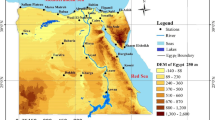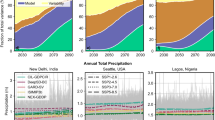Abstract
Climate model, a complex numerical representation of the global climate system, has been developed to simulate current climate and used to project future climatic conditions. Simulated climatic variables from climate models often exhibit significant deviations from observations. In climate projections, different approaches were introduced to deal with systematic deviations and random model errors. This paper demonstrates the intercomparison of four bias correction approaches (linear scaling, delta change correction, distribution mapping, and variance scaling) underlying the assumptions of stationary output from climate models. Mean monthly temperatures derived from five global climate models were corrected by four bias correction approaches for five states of southern India. The suitability of correction approaches depends upon the climate models and regional framework. The applied approaches improve the mean values and other statistical properties. The results show that all four bias techniques significantly improved the simulated data, but distribution mapping and variance scaling were more effective in removing systematic model biases.







Similar content being viewed by others
References
Asadieh B, Krakauer NY (2017) Global change in streamflow extremes under climate change over the 21st century. Hydrol Earth Syst Sci 21(11):5863–5874
Christensen JH, Boberg F, Christensen OB & Lucas‐Picher P (2008) On the need for bias correction of regional climate change projections of temperature and precipitation. Geophys Res Lett, 35(20).
Dosio A & Paruolo P (2011). Bias correction of the ENSEMBLES high‐resolution climate change projections for use by impact models: evaluation on the present climate. J Geophys Res: Atmos, 116(D16).
Fang G, Yang J, Chen Y, Zammit C (2015) Comparing bias correction methods in downscaling meteorological variables for a hydrologic impact study in an arid area in China. Hydrol Earth Syst Sci 19(6):2547–2559
Gado TA, Mohameden MB, Rashwan IMH (2022) Bias correction of regional climate model simulations for the impact assessment of the climate change in Egypt. Environ Sci Pollut Res Int 29(14):20200–20220. https://doi.org/10.1007/s11356-021-17189-9
Johnson F & Sharma A (2012) A nesting model for bias correction of variability at multiple time scales in general circulation model precipitation simulations. Water Resour Res, 48(1).
Kansara P, Lakshmi V (2021) Estimation of land-cover linkage to trends in hydrological variables of river basins in the Indian sub-continent using satellite observation and model outputs. J Hydrol 603:126997
Khan AJ, Koch M (2018) Selecting and downscaling a set of climate models for projecting climatic change for impact assessment in the Upper Indus Basin (UIB). Climate 6(4):89
Krishna Kumar K, Patwardhan SK, Kulkarni A, Kamala K, Koteswara Rao K, Jones R (2011) Simulated projections for summer monsoon climate over India by a high-resolution regional climate model (PRECIS). Curr Sci 101(3):312–326
Lazoglou G, Zittis G, Anagnostopoulou C, Hadjinicolaou P, Lelieveld J (2020) Bias correction of RCM precipitation by TIN-copula method: a case study for historical and future simulations in cyprus. Climate 8(7):85
Lemos G, Menendez M, Semedo A, Camus P, Hemer M, Dobrynin M, Miranda PM (2020) On the need of bias correction methods for wave climate projections. Global Planet Change 186:103109
Luo M, Liu T, Meng F, Duan Y, Frankl A, Bao A, De Maeyer P (2018) Comparing bias correction methods used in downscaling precipitation and temperature from regional climate models: a case study from the Kaidu River Basin in Western China. Water 10(8):1046
Maraun D (2016) Bias correcting climate change simulations-a critical review. Current Climate Change Rep 2(4):211–220
Maraun D, Widmann M (2018) Statistical downscaling and bias correction for climate research. Cambridge University Press
Maraun D, Shepherd TG, Widmann M, Zappa G, Walton D, Gutiérrez JM, Hagemann S, Richter I, Soares PM, Hall A (2017) Towards process-informed bias correction of climate change simulations. Nat Clim Chang 7(11):764–773
Miao C, Su L, Sun Q, Duan Q (2016) A nonstationary bias-correction technique to remove bias in GCM simulations. J Geophys Res: Atmos 121(10):5718–5735
Miralha L, Muenich RL, Scavia D, Wells K, Steiner AL, Kalcic M, Apostel A, Basile S, Kirchhoff CJ (2021) Bias correction of climate model outputs influences watershed model nutrient load predictions. Sci Total Environ 759:143039. https://doi.org/10.1016/j.scitotenv.2020.143039
Mishra V, Bhatia U, Tiwari AD (2020) Bias-corrected climate projections for South Asia from coupled model intercomparison project-6. Sci Data 7(1):1–13
Mohan S, Bhaskaran PK (2020) Evaluation and bias correction of global climate models in the CMIP5 over the Indian Ocean region. Environ Monit Assess 191(Suppl 3):806. https://doi.org/10.1007/s10661-019-7700-0
Palmate SS, Pandey A, Pandey RP, Mishra SK (2021) Assessing the land degradation and greening response to changes in hydro-climatic variables using a conceptual framework: a case-study in central India. Land Degrad Dev 32(14):4132–4148
Palmate SS, Wagner PD, Fohrer N, Pandey A (2022) Assessment of uncertainties in modelling land use change with an integrated cellular Automata–Markov chain model. Environ Model Assess 27(2):275–293
Pandey A, Palmate SS (2019) Assessing future water–sediment interaction and critical area prioritization at sub-watershed level for sustainable management. Paddy Water Environ 17(3):373–382. https://doi.org/10.1007/s10333-019-00732-3
Pandey BK, Khare D, Tiwari H, Mishra PK (2021b) Analysis and visualization of meteorological extremes in humid subtropical regions. Nat Hazards 108(1):661–687. https://doi.org/10.1007/s11069-021-04700-1
Pandey BK & Khare D (2021). Simulation of water balance using CORDEX over a large River Indian Basin. In World environmental and water resources congress 2021 (pp. 222–230). https://doi.org/10.1061/9780784483466.020
Pandey BK, Khare D, Kawasaki A, Meshesha TW (2021a) Integrated approach to simulate hydrological responses to land use dynamics and climate change scenarios employing scoring method in upper Narmada basin India. J Hydrol 598:126429. https://doi.org/10.1016/j.jhydrol.2021.126429
Pastén-Zapata E, Jones JM, Moggridge H, Widmann M (2020) Evaluation of the performance of Euro-CORDEX regional climate models for assessing hydrological climate change impacts in Great Britain: a comparison of different spatial resolutions and quantile mapping bias correction methods. J Hydrol 584:124653. https://doi.org/10.1016/j.jhydrol.2020.124653
Piani C, Haerter J, Coppola E (2010a) Statistical bias correction for daily precipitation in regional climate models over Europe. Theoret Appl Climatol 99(1):187–192
Piani C, Weedon GP, Best M, Gomes SM, Viterbo P, Hagemann S, Haerter JO (2010b) Statistical bias correction of global simulated daily precipitation and ftemperature for the application of hydrological models. J Hydrol 395(3):199–215. https://doi.org/10.1016/j.jhydrol.2010.10.024
Putty MRY, Prasad R (2000) Understanding runoff process using a watershed model–a case study n the Western Ghats in South India. J Hydrol 228:215–227
Räty O, Räisänen J, Ylhäisi JS (2014) Evaluation of delta change and bias correction methods for future daily precipitation: intermodel cross-validation using ENSEMBLES simulations. Clim Dyn 42(9):2287–2303
Sanjay J et al. (2020) Temperature changes in India. In: Krishnan R, Sanjay J, Gnanaseelan C, Mujumdar M, Kulkarni A, Chakraborty S. (eds) Assessment of climate change over the Indian region. Springer, Singapore. https://doi.org/10.1007/978-981-15-4327-2_2
Sillmann J, Sippel S, Russo S (2020) Climate extremes and their implications for impact and risk assessment. Elsevier
Sonali P, Nanjundiah RS, Kumar DN (2018) Detection and attribution of climate change signals in South India maximum and minimum temperatures. Climate Res 76(2):145–160
Teutschbein C, Seibert J (2012) Bias correction of regional climate model simulations for hydrological climate-change impact studies: review and evaluation of different methods. J Hydrol 456:12–29
Teutschbein C, Seibert J (2013) Is bias correction of regional climate model (RCM) simulations possible for non-stationary conditions? Hydrol Earth Syst Sci 17(12):5061–5077
Vanham D, Weingartner R, Rauch W (2011) The Cauvery river basin in Southern India: major challenges and possible solutions in the 21st century. Water Sci Technol 64(1):122–131
Acknowledgements
The climatic data used in the manuscript were received from the India Meteorological Department and CORDEX-South Asia programme. Observed temperature data were obtained from Indian Meteorological Department (IMD), India, while the CORDEX data were downloaded from the website https://esgf-data.dkrz.de/search/cordex-dkrz.
Author information
Authors and Affiliations
Corresponding author
Ethics declarations
Conflict of interest
The authors declare that there is no conflict of interests regarding the publication of this paper.
Additional information
Edited by Prof. Ioannis Pytharoulis (ASSOCIATE EDITOR) / Prof. Theodore Karacostas (CO-EDITOR-IN-CHIEF).
Rights and permissions
Springer Nature or its licensor (e.g. a society or other partner) holds exclusive rights to this article under a publishing agreement with the author(s) or other rightsholder(s); author self-archiving of the accepted manuscript version of this article is solely governed by the terms of such publishing agreement and applicable law.
About this article
Cite this article
Pandey, B.K., Chandrakar, A. & Vivek, B. Intercomparison of bias correction approaches for simulated temperature by multiple climatic models over southern India. Acta Geophys. 71, 1995–2008 (2023). https://doi.org/10.1007/s11600-023-01056-x
Received:
Accepted:
Published:
Issue Date:
DOI: https://doi.org/10.1007/s11600-023-01056-x




